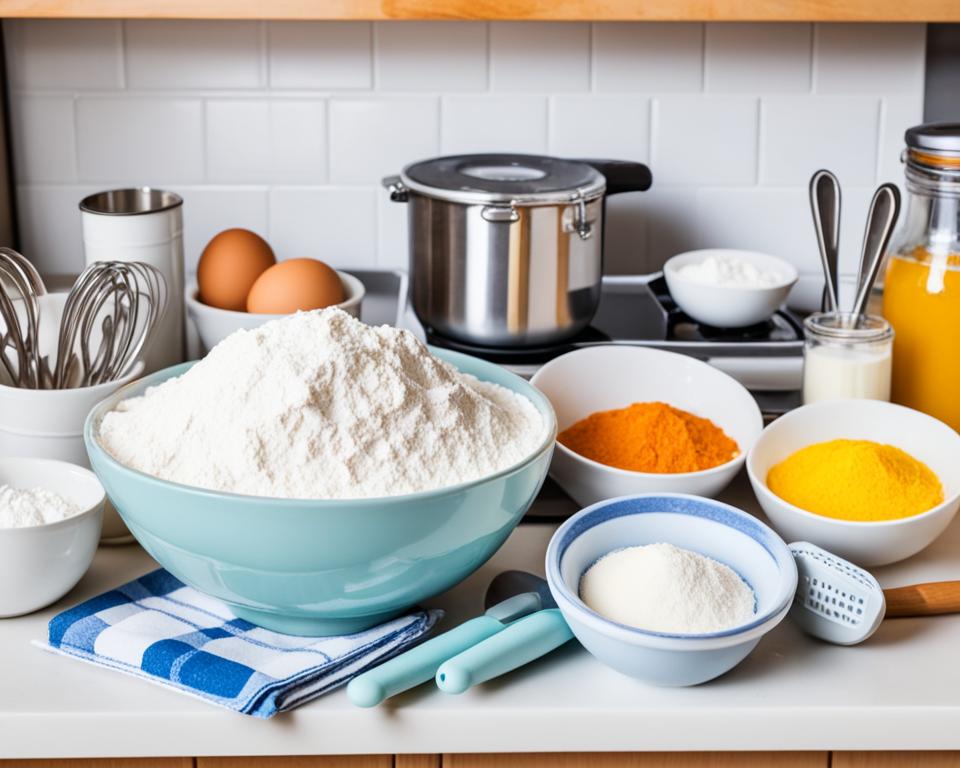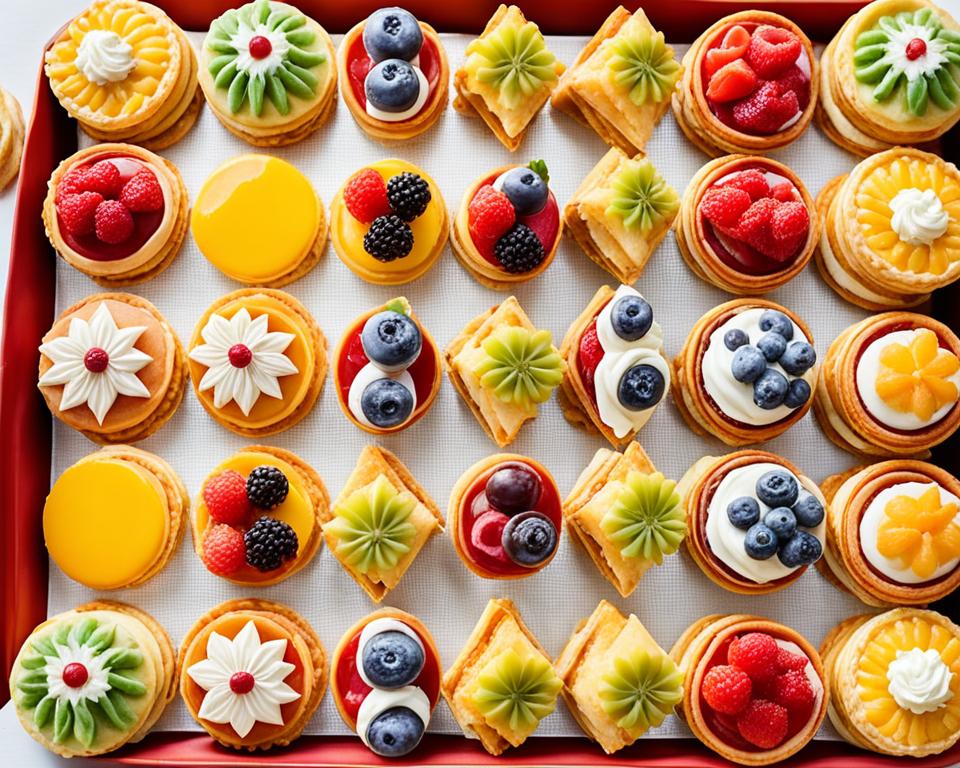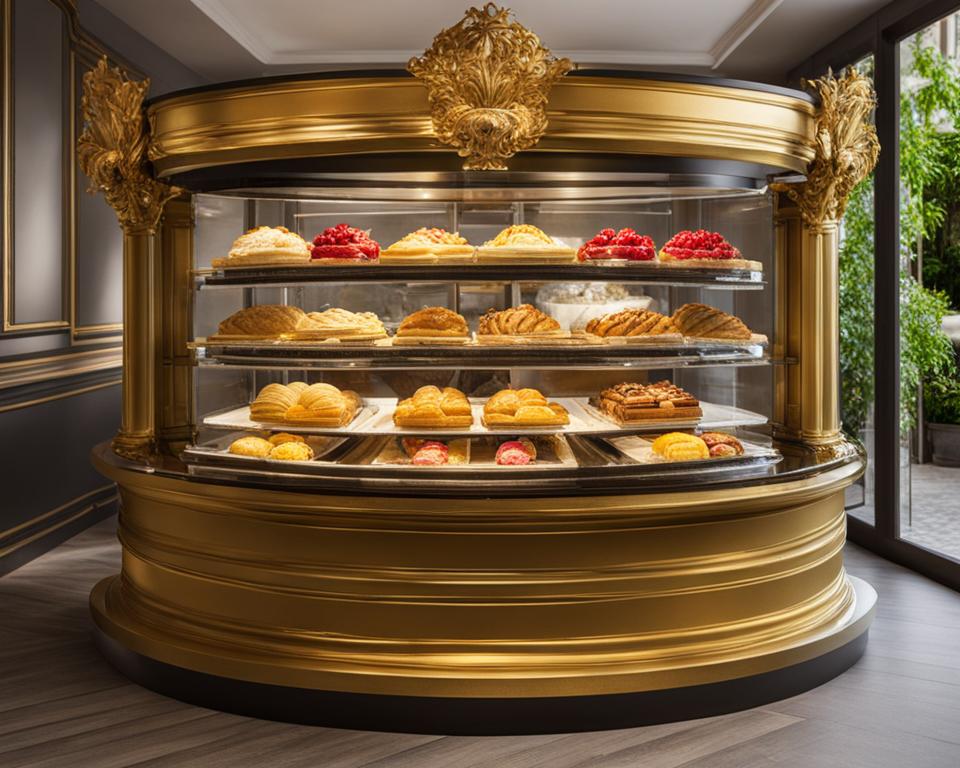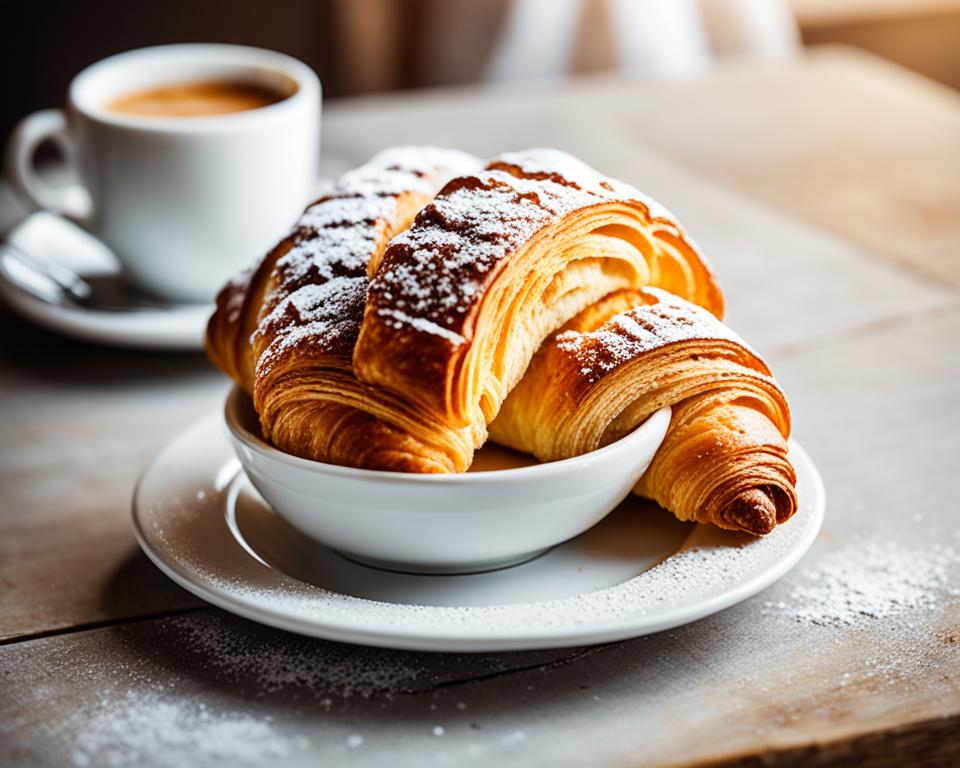Learning how to bake can be a fun and rewarding experience, whether you’re a beginner or an occasional baker. To ensure your baking endeavors are a success, it’s important to have the right knowledge and techniques. This article provides basic tips and techniques that will help you achieve delicious results every time you step into the kitchen.
Key Takeaways:
- Learn the importance of ingredient preparation, including using room temperature ingredients and fresh leavening agents.
- Understand when and how to substitute ingredients in your recipes, taking note of the different characteristics of flours.
- Master the art of accurate ingredient measurement using the right tools and techniques.
- Discover various mixing techniques and when to use them for different baked goods.
- Read and comprehend recipes thoroughly to ensure you follow the instructions accurately.
How to Prepare Your Ingredients
Before embarking on any baking recipe, it’s crucial to properly prepare your ingredients. This step ensures that you have everything in order and sets the foundation for a successful baking experience. Here are some key considerations when it comes to ingredient preparation:
- Read the recipe thoroughly and gather all the necessary ingredients before starting. This will save you time and prevent any last-minute scrambling.
- Most baking recipes require room temperature ingredients, unless specified otherwise. Leaving ingredients out on the counter for about an hour before baking can help remove the chill and ensure even baking throughout.
- Using fresh ingredients is paramount for achieving the best results. Pay attention to the expiration dates of dairy products, eggs, and other perishable ingredients to ensure optimal freshness.
When it comes to leavening agents like yeast, baking soda, and baking powder, using fresh ones is non-negotiable. These ingredients play a crucial role in the rise and texture of your baked goods, so make sure they are within their shelf life and haven’t expired.
By taking the time to properly prepare your ingredients, you set yourself up for baking success. So, gather your fresh ingredients, bring them to room temperature, and let’s dive into the world of baking!
Substituting Ingredients
While it’s best to follow a recipe exactly as written, there are times when substitutions may be necessary. However, it’s important to tread carefully when making substitutions, as they can significantly impact the outcome of your baked goods. Understanding the characteristics of different flours is crucial when substituting.
Lower protein flours like cake flour produce a more delicate texture, while higher protein flours like bread flour create a chewier texture.
When substituting flour, it’s essential to adjust the measurements accordingly. Substituting with whole wheat flour should be done cautiously, as it can result in denser and drier baked goods.
How to Measure Your Ingredients
Accurate measurement of ingredients is essential in baking, as it is a science that relies on precise quantities. Using the right tools is crucial when measuring ingredients. Here are some tips to help you measure your ingredients accurately:
1. Measuring Tools
Choose the appropriate measuring tools for different ingredients. Volumetric cups are ideal for measuring dry ingredients like flour, sugar, and cocoa powder. Pyrex measuring cups with a spout are great for measuring liquids such as milk, water, and oil. Measuring spoons should be used for small quantities of ingredients like baking soda, salt, and spices.
2. Flour Measurement
When measuring flour, it’s important to fluff it up with a spoon before scooping it into the cup. This helps to aerate the flour and ensure proper measurement. Use a flat edge, like a knife or the back of a spoon, to level off the excess flour. Avoid tapping the cup, as it can lead to an excessive amount of flour and affect the texture of your baked goods.
3. Liquid Measurement
For accurate liquid measurement, place the measuring cup on a flat surface and pour the liquid to the desired level. Read the measurement at eye level to ensure accuracy.
4. Teaspoon vs. Tablespoon
Understanding the difference between teaspoons and tablespoons is crucial in baking. These measurements can greatly impact the outcome of your recipes. A teaspoon (tsp) is smaller and typically used for smaller quantities of ingredients like baking soda, baking powder, and vanilla extract. A tablespoon (tbsp) is larger and commonly used for larger quantities of ingredients like oil, butter, and sugar. Pay attention to the recipe instructions to make sure you use the correct measurement.
By following these tips and using the right measuring tools, you can ensure accurate ingredient measurement and improve the chances of success in your baking endeavors.
How to Mix Ingredients
The way in which ingredients are mixed can greatly affect the texture and structure of baked goods. Different recipes may call for different mixing techniques. Understanding these techniques and following the specific mixing instructions provided in the recipe is crucial for achieving the desired outcome.
The Creaming Method:
The creaming method is commonly used in cake and cookie recipes. It involves blending the butter and sugar together until light and fluffy. This step creates air bubbles that will expand during baking, resulting in a lighter texture. To use the creaming method, follow these steps:
- Start with softened butter at room temperature
- Add the sugar gradually
- Beat the mixture until it becomes light and fluffy
Using an electric mixer is recommended for this method, as it helps achieve the desired texture more easily.
The Muffin Method:
The muffin method is used for quick breads and muffin recipes. It involves mixing the wet and dry ingredients separately and then combining them just until incorporated. This method helps ensure a tender texture. To use the muffin method, follow these steps:
- Mix the dry ingredients together in a separate bowl
- Mix the wet ingredients together in another bowl
- Pour the wet ingredients into the dry ingredients
- Stir just until the dry ingredients are moistened and no dry patches remain
It’s important not to overmix when using the muffin method, as it can lead to dense and tough baked goods.
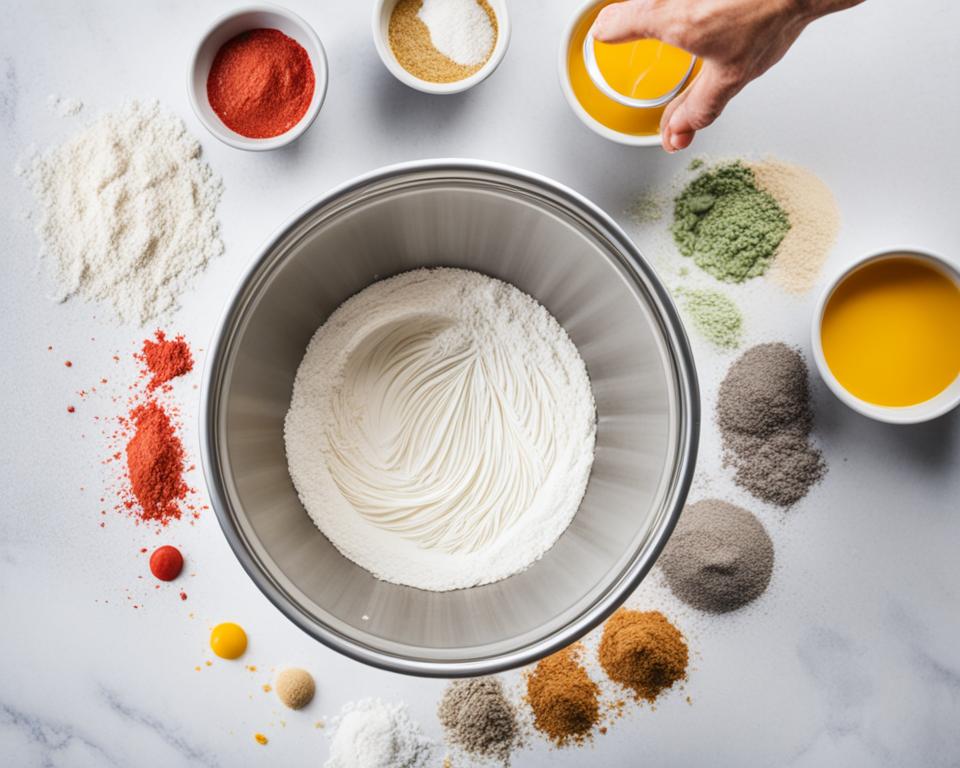
Experimenting with different mixing techniques and understanding their effects can help you achieve the desired texture and structure in your baked goods. Whether you’re using the creaming method for light and fluffy cakes or the muffin method for tender quick breads, following the mixing instructions provided in the recipe will ensure baking success.
The Importance of Reading the Recipe
Properly reading and understanding a recipe is vital for successful baking. Before starting, it’s important to read through the entire recipe from beginning to end. This allows you to familiarize yourself with the ingredients, instructions, and any potential variations or additional steps. Pay close attention to the order of ingredients in the ingredient list, as it often indicates the order in which they will be used. Understanding the structure and flow of the recipe will help you execute each step accurately.
When it comes to recipe reading, the devil is in the details. Take the time to carefully read and comprehend each instruction, ensuring that you understand the specific actions required. This will prevent any surprises or mistakes along the way and help you achieve the desired outcome.
It’s like solving a puzzle – each step of the recipe is a piece that fits together to create a delicious masterpiece.
Recipe comprehension goes beyond simply knowing what ingredients are needed and what steps to follow. It involves understanding the purpose of each ingredient and how they contribute to the overall flavor and texture of the finished product. Reading the recipe thoroughly also allows you to identify any potential substitutions or adjustments that may be necessary based on dietary restrictions or personal preferences.
By taking the time to read and understand the recipe before you begin, you can avoid unnecessary mishaps and ensure a smooth baking process. It sets the foundation for success in the kitchen and helps you confidently navigate the recipe, regardless of its complexity.
Recipe Structure and Organization
Recipes are typically structured in a standardized format to ensure clarity and ease of comprehension. Understanding this structure can make the reading process more efficient and help you follow the instructions seamlessly.
Most recipes start with a title or a brief introduction, followed by a list of ingredients. The ingredient list includes the quantities and types of each ingredient required for the recipe. Paying close attention to the order of ingredients in the list is important, as it often corresponds to the order in which they will be used.
After the ingredients, the recipe provides step-by-step instructions on how to prepare and combine the ingredients. Each instruction should be read carefully, ensuring you understand the specific tasks and techniques required. Some recipes may provide additional tips or variations, which can enhance your baking experience and allow for customization.
| Recipe Structure | Example |
|---|---|
| Title/Introduction | Classic Chocolate Chip Cookies |
| Ingredients |
|
| Instructions |
|
As you can see from the example above, the structure of a recipe helps organize the necessary information in a clear and concise manner. By reading and familiarizing yourself with this structure, you can navigate recipes with ease and confidence. Whether you’re a novice baker or a seasoned pro, recipe reading and comprehension are key skills that will take your baking to the next level.
Ingredient Temperature and Actions
Recipe instructions often specify the temperature and actions required for specific ingredients. This information is crucial for achieving the desired outcome. Pay attention to whether ingredients should be at room temperature, melted, softened, or in other specific states.
Actions such as mincing, chopping, or grating should be done before measuring the ingredient. Understanding these temperature and action requirements will help ensure proper incorporation and texture in your baked goods.
Room Temperature Ingredients
Some recipes call for ingredients to be at room temperature, particularly eggs, butter, and dairy products. Bringing these ingredients to room temperature allows for better incorporation into the mixture, resulting in a smoother batter or dough.
For example, when making a cake, room temperature eggs emulsify better with the other ingredients, creating a lighter and more tender crumb. Similarly, room temperature butter mixes more evenly with sugar, resulting in a better creaming process.
Softening Ingredients
Softening ingredients like butter or cream cheese are often required for certain recipes, such as cookies or cheesecakes. Softening creates a creamy and easily workable texture, allowing for smoother mixing and incorporation.
To soften butter, leave it at room temperature for about 30 minutes or until it becomes easy to press with a finger. For cream cheese, you can either let it sit at room temperature or microwave it in short intervals until softened.
Melting Ingredients
Some recipes may call for melted ingredients like chocolate or butter. Melting these ingredients changes their physical properties, making them easier to incorporate into the recipe.
To melt chocolate, chop it into small pieces and place them in a heatproof bowl. Microwave in short intervals, stirring in between, until smooth and fully melted. For butter, cut it into cubes and melt it gently in a saucepan over low heat or in the microwave.
Actions Before Measurements
When a recipe specifies actions like mincing, chopping, or grating, it’s important to perform these tasks before measuring. This ensures accurate measurement and even distribution of the ingredient throughout the recipe.
For example, if a recipe calls for minced garlic, mince the garlic cloves first and then measure the required amount. This ensures that the flavor and texture of the minced garlic are evenly distributed in the dish.
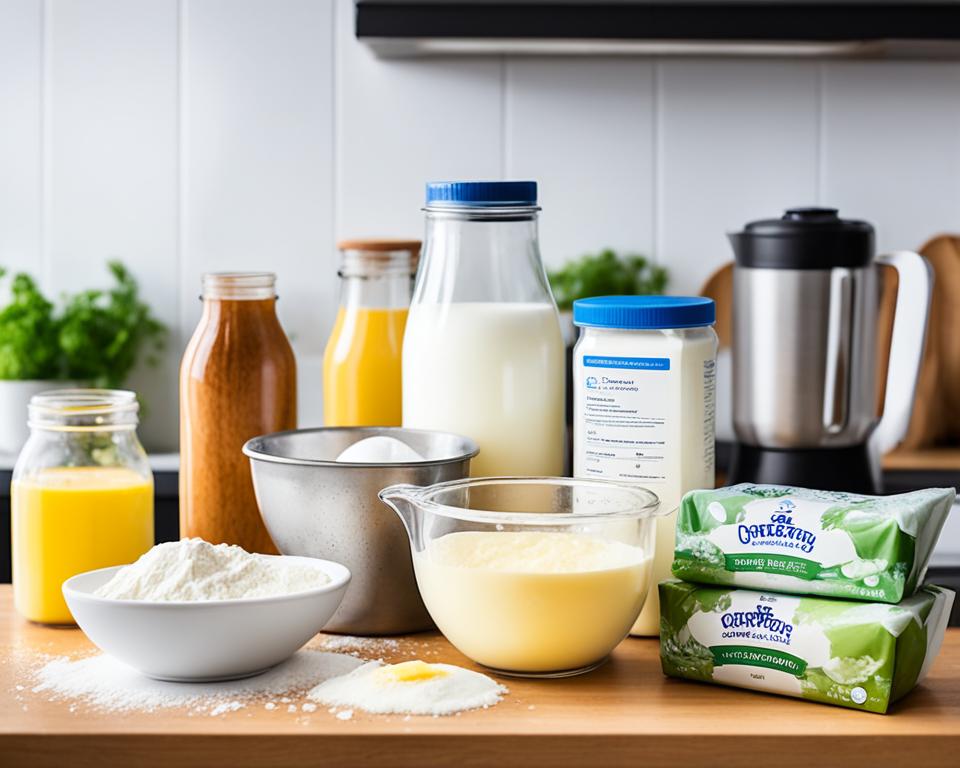
| Ingredient | Temperature/State | Actions |
|---|---|---|
| Eggs | Room temperature | – |
| Butter | Room temperature or softened | – |
| Cream cheese | Room temperature or softened | – |
| Chocolate | Melted | – |
| Garlic | – | Mincing |
| Cheese | – | Grating |
Understanding Doneness
Determining when your baked goods are fully cooked, also known as achieving the perfect “doneness,” is a crucial skill every baker should master. While recipe instructions often provide a time range for baking, relying solely on these guidelines may not always guarantee the best results. To truly achieve perfection, it’s important to pay attention to visual cues and even consider temperature testing to ensure that your creations are cooked to perfection.
Visual Cues for Doneness
Visual cues can be a helpful indicator of when your baked goods are done. As they bake, they undergo various transformations, such as browning or rising, that can provide valuable insight into their doneness. Here are some common visual cues to look for:
- Browning: The edges and tops of your baked goods may turn golden brown when they are nearing doneness. This is often a sign that they have developed a deliciously crisp exterior. However, be cautious as excessive browning could indicate overcooking.
- Rising: Certain baked goods, like bread or cakes, may rise during baking. Monitor the rise closely, as it can help determine when the structure is fully set and the ingredients have cooked thoroughly.
- Texture: Texture can be another visual cue to assess doneness. For instance, a cake is typically considered done when the center springs back when lightly touched, indicating that it is fully set and has a tender crumb.
Remember, visual cues may vary depending on the recipe and the type of baked good you are preparing. It is important to follow the specific instructions provided and take into account any unique characteristics of the recipe.
Temperature Testing
While visual cues are helpful, some recipes may require a more precise method of determining doneness. In such cases, temperature testing can provide accurate results. Using an instant-read thermometer, you can measure the internal temperature of your baked goods. Here are a few key temperature guidelines for commonly baked items:
| Baked Good | Internal Temperature |
|---|---|
| Cookies and Bars | 190°F (88°C) |
| Cakes and Cupcakes | 195°F (90°C) – 205°F (96°C) |
| Breads and Rolls | 190°F (88°C) – 210°F (99°C) |
| Custards and Cheesecakes | 160°F (71°C) – 165°F (74°C) |
Again, it’s important to consult the recipe for specific temperature guidelines, as different recipes may have varying recommendations based on the desired texture and doneness.
Keep in mind that practice and experience play a significant role in determining doneness. As you bake more frequently, you’ll develop a keen eye and a sense of timing that will contribute to your ability to assess doneness accurately.
By combining visual cues with temperature testing, you can confidently determine when your baked goods are perfectly done. Whether you’re aiming for a soft and gooey center or a crispy exterior, paying attention to these indicators will help you achieve baking success every time.
The Benefits of Understanding Recipes
Taking the time to understand recipes thoroughly can greatly contribute to your baking success. By reading the recipe from start to finish, understanding the ingredient list, and following the instructions precisely, you can avoid mistakes and achieve the desired results.
“Recipes are designed to guide you through the baking process, providing valuable information and tips along the way.”
Recipes serve as a roadmap for your baking journey, offering a wealth of knowledge and guidance. They provide step-by-step instructions on how to mix ingredients, measurements, and even baking times and temperatures. Decoding recipes and comprehending their structure can help you become more efficient and confident in the kitchen.
Not only do recipes provide you with the necessary steps to create a delicious treat, but they also offer invaluable tips and tricks to improve your skills and enhance the final outcome. From highlighting specific techniques to showcasing variations and substitutions, recipes are packed with helpful information tailored to each dish.
The Importance of Recipe Comprehension
Recipe comprehension is key to achieving consistent baking success. By understanding the order of operations, you can ensure that each ingredient is added at the right time and in the correct manner. This prevents missing crucial steps that can impact the overall texture and flavor of your baked goods.
Additionally, decoding recipes allows you to identify any unfamiliar terms or techniques, enabling you to expand your baking knowledge. This newfound understanding opens up a world of possibilities as you gain the confidence to experiment and create your own unique recipes.
By comprehending recipes, you can also troubleshoot potential issues before they arise. Recognizing the purpose of each ingredient and how they interact with one another gives you the power to make adjustments and substitutions when necessary. This flexibility allows you to cater recipes to your personal preferences and dietary restrictions.
Recipe Success through Understanding
Recipe success is not just about following the instructions blindly but understanding the reasoning behind each step. When you comprehend the purpose of specific techniques, such as creaming butter and sugar together or folding ingredients gently, you can appreciate their impact on the final product.
Understanding recipes also empowers you to adapt them to different baking scenarios. For example, if you’re short on time and need to speed up the rising process, knowing the yeast’s role and its impact on dough allows you to strategize accordingly.
The knowledge gained from recipe comprehension becomes a valuable tool that you can apply to other baking endeavors. As you familiarize yourself with various recipe structures and techniques, you’ll develop a deeper understanding of the science behind baking. This knowledge will serve as a foundation for your future culinary creations.
Overall, taking the time to decode and comprehend recipes enhances your baking abilities and opens up a world of culinary possibilities. So, let your curiosity guide you as you dive into the world of recipes, always ready to learn and explore.
The Importance of Ingredient Quality
Using fresh, high-quality ingredients is essential for baking success. When it comes to achieving the perfect rise in your baked goods, ingredient freshness is key. Leavening agents like yeast, baking soda, and baking powder need to be active and fresh to provide the necessary lift. Stale or expired leavening agents can result in flat, dense baked goods.
But it’s not just leavening agents that require freshness. Eggs, dairy products, and produce can greatly impact the flavor and texture of your baked goods. Fresh eggs contribute to better structure and moisture, while fresh dairy products add richness and creaminess. And let’s not forget about the importance of fresh fruits and vegetables in achieving vibrant flavors and appealing visual appeal.
Using fresh, high-quality ingredients elevates the overall quality of your baked goods. It’s like starting with a solid foundation for baking success.
Whenever possible, opt for fresh, locally sourced ingredients. Not only does this support local farmers and businesses, but it also ensures that you’re getting the best quality ingredients. Local ingredients are often harvested at their peak, guaranteeing optimal freshness and flavor.
Paying attention to ingredient quality is an investment in your baking success. By using fresh, high-quality ingredients, you’re setting yourself up for delectable results that will impress both your family and friends.
To further illustrate the importance of ingredient quality, here’s a comparison of the effects of using fresh versus expired baking soda in a classic chocolate chip cookie recipe:
| Ingredient | Result with Fresh Baking Soda | Result with Expired Baking Soda |
|---|---|---|
| Cookie Texture | Light and fluffy | Dense and flat |
| Taste | Balanced and flavorful | Off-taste and bitterness |
| Cookie Appearance | Golden brown and evenly spread | Pale and uneven spread |
As you can see from the comparison, using fresh ingredients, such as baking soda, can make a significant difference in the outcome of your baked goods. So, never underestimate the impact of ingredient quality on your baking success!
The Role of Practice and Experience
Baking is a skill that improves with practice and experience. While the tips and techniques provided in this article are valuable, it’s important to remember that mastering baking takes time and patience. Don’t be discouraged by initial failures or minor setbacks. Take the time to experiment, learn from your mistakes, and adapt recipes to suit your preferences. With consistent practice and a willingness to learn, you can become a confident and successful baker.
Embrace the Journey of Baking
Baking is not just about following a recipe; it’s about developing a deep understanding of ingredients, techniques, and flavors. Every baking session is a chance to learn and improve.
Just like any other skill, baking requires practice. Even the most talented bakers started as beginners. Embrace the learning process and celebrate every step forward.
As you continue to bake, you’ll gain a better understanding of the science behind baking and how different ingredients interact with each other. This knowledge will allow you to make adjustments and experiment with new flavors and techniques.
Learn from Your Mistakes
Not every baking attempt will be perfect, and that’s okay. Mistakes are opportunities for growth and learning.
Thomas Edison once said, “I have not failed. I’ve just found 10,000 ways that won’t work.” Approach baking with the same mindset. Each “failed” attempt brings you closer to success.
When a recipe doesn’t turn out as expected, take the time to analyze what might have gone wrong. Was the oven temperature accurate? Did you measure the ingredients correctly? By identifying the potential sources of error, you can adjust your techniques for future baking endeavors.
Experiment and Adapt
While it’s important to follow recipes as a beginner, don’t be afraid to experiment and adapt them to your taste and preferences.
Baking is both an art and a science. Put your own twist on recipes and let your creativity shine. You might stumble upon a unique flavor combination that becomes your signature bake.
Try adding different spices, substituting ingredients, or even combining different recipes to create something entirely new. As you gain more baking experience, you’ll develop a sense of what works and what doesn’t, allowing you to create your own delicious creations.
Continued Growth and Improvement
Baking is a lifelong journey. There will always be new techniques to learn, flavors to explore, and challenges to overcome.
Baking is like a beautiful puzzle with endless possibilities. The more you practice and explore, the more confident and skilled you’ll become.
Keep challenging yourself with new recipes and techniques. Attend baking workshops or join online communities of fellow bakers to exchange tips and tricks. The more you immerse yourself in the baking world, the more you’ll grow as a baker.
Remember, baking is not just about the end result; it’s about the joy of the process. Enjoy every moment spent in the kitchen and savor the delicious rewards of your efforts.
| Key Takeaways |
|---|
| Practice and experience are essential for improving your baking skills. |
| Don’t be discouraged by failures; they are opportunities for learning and growth. |
| Experiment with recipes and adapt them to suit your preferences. |
| Continuously seek new techniques, flavors, and challenges to enhance your baking abilities. |
Conclusion
Baking can be a truly fulfilling and delightful activity when armed with the right knowledge and tips for success. By incorporating the basic tips outlined in this article, you can elevate your baking skills and achieve mouthwatering results. From carefully preparing your ingredients and measuring accurately to utilizing proper mixing techniques and comprehending recipes, you can transform into a confident and accomplished baker. Let your creativity flourish in the kitchen as you embrace the joy of baking.
Remember, success in baking is not just about following a recipe—it’s about understanding the techniques behind it. By mastering the fundamentals, you can confidently explore new flavors, experiment with different ingredients, and even create your own signature recipes. The key is to keep practicing and learning from your experiences. Over time, you’ll gain the confidence and expertise to tackle new challenges and create breathtakingly delicious baked goods.
So go ahead, immerse yourself in the world of baking. With these valuable tips and a sprinkle of passion, you’ll be well on your way to becoming a baking maestro. Enjoy the process, savor the aromas, and delight in the incredible taste of your homemade creations. May every baking adventure fill you with satisfaction, as you continue to hone your skills and create countless moments of joy and deliciousness.
FAQ
What are some basic tips for successful baking?
Basic tips for successful baking include preparing ingredients properly, understanding and following the recipe, measuring ingredients accurately, mixing ingredients correctly, and determining when baked goods are fully cooked.
Why is it important to prepare ingredients properly?
Properly preparing ingredients, such as bringing them to room temperature and using fresh leavening agents, ensures even baking and helps achieve the desired texture and structure in baked goods.
Can I make substitutions in baking recipes?
Substitutions can be made in baking recipes, but it’s important to tread carefully as they can significantly impact the outcome. Understanding the characteristics of different flours and adjusting measurements accordingly is crucial when substituting.
How should I measure my ingredients accurately?
Accurate measurement of ingredients is important in baking. Volumetric cups should be used for dry ingredients, pyrex measuring cups for liquids, and measuring spoons for small quantities. When measuring flour, it’s important to fluff it up and level off the excess with a flat edge.
What are some different mixing techniques in baking?
Different recipes may call for different mixing techniques. The creaming method involves blending butter and sugar until light and fluffy, while the muffin method involves combining wet and dry ingredients just until incorporated. Following the specific mixing instructions provided in the recipe is important for the desired texture.
How should I read and understand a recipe?
Before starting, it’s important to read through the entire recipe from beginning to end, familiarize yourself with the ingredients and instructions, and pay close attention to the order of ingredients in the list. Understanding the structure and flow of the recipe will help you execute each step accurately.
Why is ingredient temperature and action important in baking?
Ingredient temperature and action requirements are important for achieving the desired texture and incorporation in baked goods. Paying attention to whether ingredients should be at room temperature, melted, softened, or in other specific states will greatly impact the outcome.
How can I determine if my baked goods are fully cooked?
Recipe instructions typically provide a time range and visual cues to assess doneness. Setting a timer for the lowest indicated time and using visual cues like browning or rising can help determine if the baked goods are fully cooked. In some cases, an internal temperature reading may be necessary.
Why is it beneficial to understand recipes thoroughly?
Understanding recipes thoroughly helps avoid mistakes and achieve the desired results. Reading the recipe from start to finish, understanding the ingredient list, and following the instructions precisely will enhance your baking abilities and lead to successful outcomes.
How does ingredient quality affect baking?
Using fresh, high-quality ingredients is essential for successful baking. Fresh leavening agents and ingredients like eggs, dairy products, and produce greatly impact the flavor and texture of baked goods. Opting for fresh, locally sourced ingredients when possible will elevate the overall quality.
How can I improve my baking skills?
Baking is a skill that improves with practice and experience. Embrace the joy of baking, learn from your mistakes, and adapt recipes to suit your preferences. Consistent practice and a willingness to learn will lead to confidence and success in baking.

